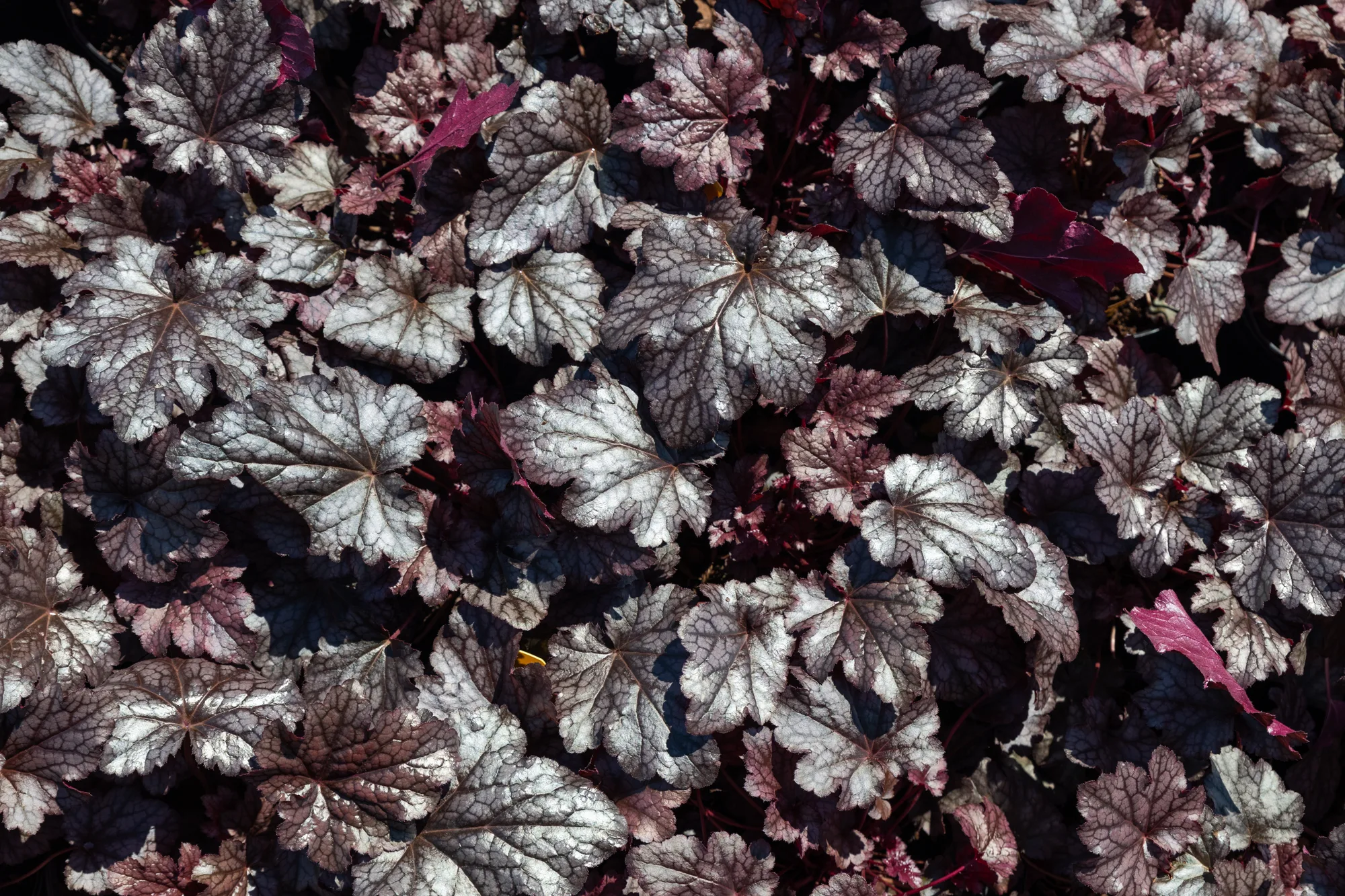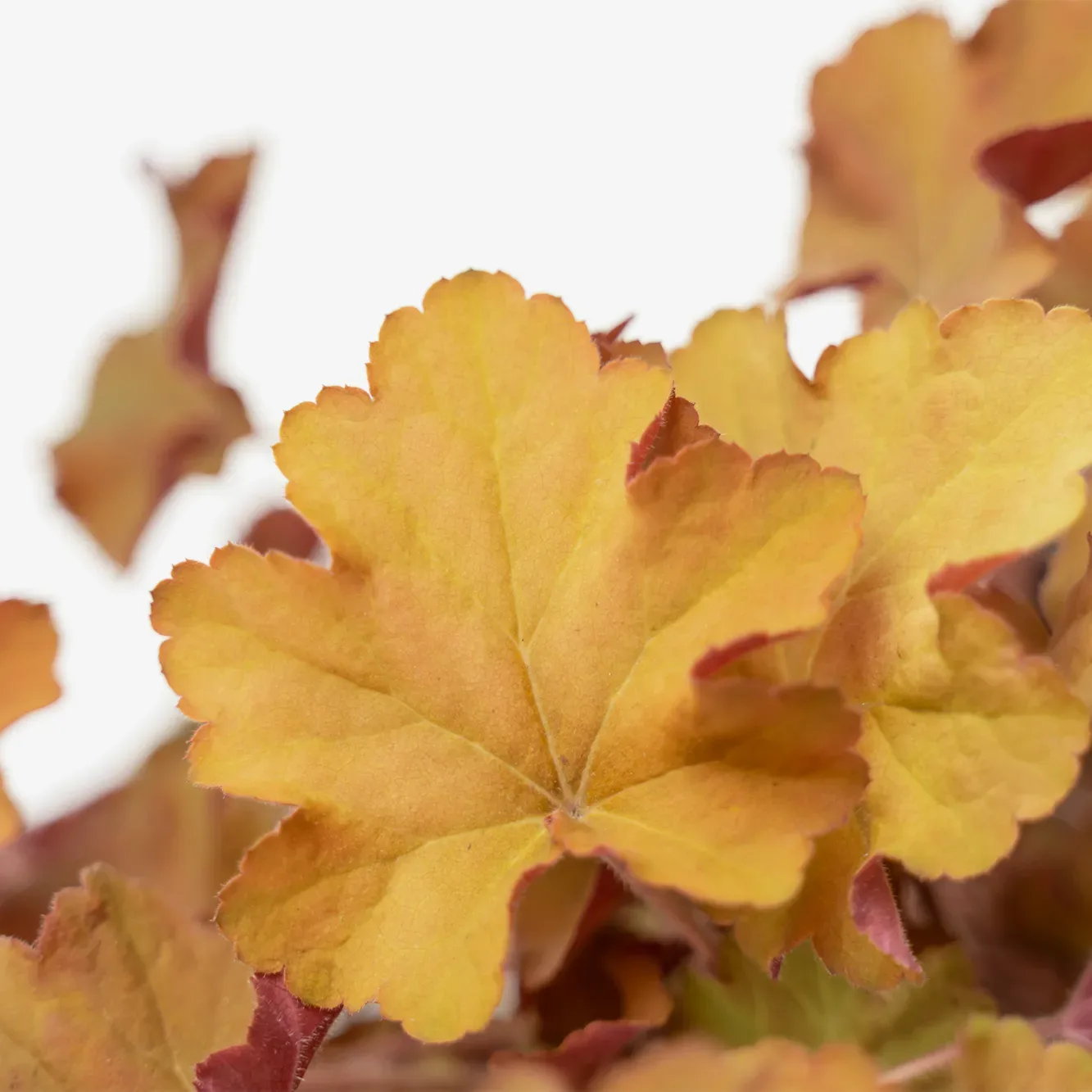
Written by s • Ring the Bell for Coral Bells
When they come into our gardens, some plants stay pretty much the same as they are in the wild, but others are changed dramatically by keen growers, who see some potential and go with it. That is the story of coral bells in our gardens. Heuchera, as these plants are called, is a group of 30-odd plants that grow across America, mostly in the south-west. With an eye for color, it was Heuchera sanguinea, from the dry canyons of New Mexico, that first caught the attention of gardeners, for its abundance of wispy stems carrying small but brightly-colored red flowers in summer. It was those flowers that gave us the common name of ‘coral bells’ for these plants, although the name ‘alumroot’ is often used as well. The root contains tannic acid, which makes it astringent, in the same way as the chemical alum is used to close small cuts after shaving.
That original coral bells has the great advantage of growing in shadier parts of the garden, where the sparkling red blooms brighten the summer garden, while the low mound of leaves do a pretty good job of covering the ground. For a long time gardeners grew plants only for their flowers, so an appreciation of foliage didn’t really develop until about 50 years ago. So the other coral bells – which mostly have greenish or white flowers – were only grown by collectors and gardening professionals.
Today foliage is recognized as vital for an attractive garden, and a closer look at the leaves of different coral bells opens up a whole world of variety – a variety that has been picked up and run with by breeders. The result? Today Heuchera is a foliage plant, valuable for its shade-tolerance and generally hardiness, and available in colors from avocado green to blood red. Let’s take a closer look. . .
Just Call Me Heuchera
Because they are foliage plants, and most have insignificant or white flowers, it might make sense to drop ‘coral bells’ and join the botanists by calling these plants ‘Heuchera’ – which is pronounced ‘Hu-ker-a’, with the ‘a’ as in ‘about’ – named after a German doctor of the 18th century called Johann von Heucher. But whatever you decide to call it, the important thing is to be growing it!
How to Grow Coral Bells
What makes these plants so useful to all gardeners is their versatility. They are hardy all the way from zone 4 to zone 9, surviving cold, but not needing any winter-chill to grow well. They are also very tolerant of different light levels. Most will grow happily in full sun in cooler zones, if the soil isn’t too dry, and they all love partial shade and even moderate full shade. Most of the colored forms tend to ‘green’ when planted in too much shade, and become thinner in growth too, but the ability of this plant to survive in darker parts of the garden is amazing. Just about any well-drained soil will be perfect, and these are plants that do well in alkaline soils – in fact they don’t like very acidic ones – so they are great if you live in limestone.
They take very little care – just pull off brown leaves if they look unsightly, and remove the flower stems with a gentle tug once they are over. Bugs and critters like deer leave them alone too, and some will even tolerate salt-spray. If they become too large they can be divided, or trim back the horizontal stems that grow across the surface of the soil.
Coral Bells for Your Garden
The first coral bells grown in gardens were of course the original wild species, collected as seeds from their homes in America.
Heuchera sanguinea – Coral Bells. This plant grows wild in Mexico, New Mexico and Arizona, and certainly deserves to keep the name ‘coral bells’ to distinguish it from the heuchera grown for foliage. It grows in dry areas, but in shady crevices and on the north side of boulders, which is why it is so shade tolerant. It was once the only variety found in gardens, and in the 50s, 60s and 70s it was popular, with several different varieties with different shade of red flowers. It flowers in summer, and the slender stems rise at least a foot above the leaves, waving gently in the breeze, and making an attractive show in a rock garden or the front of a flower bed. It’s a plant definitely still worth growing, full of charm.
Heuchera americana – American Alumroot. While most come from the south-west, this is a heuchera that is found in the east, and in central states. The wild plant has rounded green leaves, and the flowers are white, but several garden forms have been created, including ‘Garnet’, with dark red foliage.
Heuchera villosa – Hairy Alumroot. This species is also from the east, where it grows on rocky outcrops and cliffs in both sides of the Appalachians. The leaves are very full and rounded, with pronounced pointed lobes, like a maple-leaf. It produced the first popular heuchera with colored leaves – the still-popular ‘Palace Purple’. Stories vary, but this is most likely a unique individual found in the wild by a retired botanist, Edgar Wherry, west of the Appalachians, in the 1970s. It was ‘re-disovered’ by Brian Halliwell, a curator at England’s Royal Botanical Gardens, who named it after a palace on the grounds of the Gardens where he found it growing. It remains one of the most durable and reliable of the colored leaf heuchera.

Heuchera Hybrids. Most of the many popular varieties with colored leaves are hybrids, often of ‘uncertain origin’, as horticulturists like to say. They are often chance seedlings found in nurseries, and one nursery that has produced several of the best is the small but active perennials nursery outside the French town of Lille, run by Sandrine and Thierry Delabroye. They have given us the wonderful ‘Caramel’, a variety with gorgeous orange leaves in spring, which turn caramel-apricot for the summer. It’s a vigorous plant, with a broad spreading growth pattern, that is perfect for filling areas in sun or shade. It could be a form of H. villosa, but we aren’t sure.
Another thoroughbred from the Delabroye stables is ‘Guacamole’, a very different heuchera with lime-green foliage – always a popular and fashionable garden color. Try running a line of lime-green along a path in a shady place and see how it pops and brightens a gloomy place.
Some varieties of coral bells can suffer in the heat and humidity of the southeast, developing unsightly mildew, or leaf burn. Since the whole point is to have attractive foliage, this is not good. If this is something that puts you off growing them, try ‘Electric Plum’. The spring leaves are a wonderful black-purple, and through summer it is purple-pink with striking black veins – a real beauty. Best of all, this complex hybrid has the vigor to take drought, heat and humidity without damage, so if that sounds like your climate, this one’s for you. It is the work of Hans Hansen, owner of Walters Gardens, Inc., a wholesale perennial nursery in Zeeland, Michigan.
There are many more hybrids, enough for a dozen gardens, so you can build a collection of these colorful and easy-care plants – and why not?





